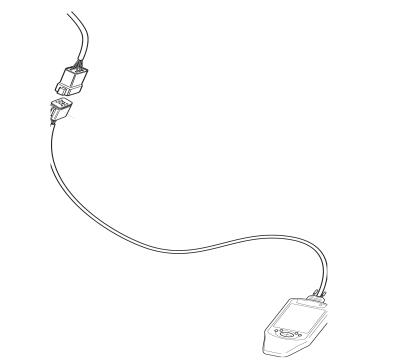
Function, VODIA
By using the VODIA tool (3838619) in position “Parameters, reprogramming” you can read off and adjust the parameters stated below. The VODIA tool is connected to the diagnostics connector (6-pin connector block) located beneath the “cable cover” on the left side of the engine, or by using T-diagnostic connector no. 874427. Refer to the “VODIA user guide” for help in using the tool.
Adjustable parameters
NOTE: VODIA is used to adjust parameters in CIU and EMS2. Some parameters require special authorization.
Functions
Primary control mode | |
Selects which regulator is to be used when there is no primary control switch. | |
Alternative position | “Isochronal”or“droop” characteristic |
Preset position | “Isochronous” |
Control gradient (Droop) | |
Determines the engine speed droop to be used (gradient) | |
Min. value | 0% |
Preset value | 4% |
Max. value | 8% |
Lamp test | |
This parameter determines if a lamp test is to be performed when the system is started. | |
Alternative position | “Off” or “On” |
Preset position | “On” |
Idle. | |
Sets the idle speed. | |
Min. value | 600 rpm |
Preset value | 900 rpm |
Max. value | 1200 rpm |
Pre-heating before ignition | |
Selects if pre-heating is activated directly when the ignition is turned on. If the parameter “Off” has been selected, pre-heating must be activated manually via the ignition lock or pre-heater button. | |
Alternative position | “Off” or “On” |
Preset position | “Off” |
Connected to system voltage during running/stop, EMS | |
Stops input data to the CIU unit connected to system voltage at “run” or “stop”. | |
Preset position | “Stop” |
Connected to system voltage during running/stop, CIU | |
Stops input data to the CIU unit connected to system voltage at “run” or “stop”. | |
Preset position | “Stop” |
Idle voltage, CIU | |
Voltage of the throttle signal corresponding to idle at the CIU unit. | |
Min. value | 0.3 V |
Preset value | 1.17 V |
Max. value | 1.9 V |
Voltage max. rpm CIU | |
Voltage of the throttle signal corresponding to full throttle at the CIU unit. | |
Min. value | 1.9 V |
Preset value | 4.5 V |
Max. value | 4.7 V |
Alarm limits | |
Alarm limit, high coolant temperature | |
a warning lamp is lit at this temperature. | |
Min. value | 95 °C |
Preset value | 104 °C |
Max. value | 103 °C |
Engine protector | |
Engine protector coolant temperature | |
Determines if engine protection shall be activated in response to high coolant temperature. | |
A fault code is registered and the engine is shut down. | |
Alternative position | “Off” or “On” |
Preset value | “On” |
Engine protector coolant level | |
Determines if engine protection shall be activated in response to low coolant level. | |
Alternative position | “Off” or “On” |
Preset value | “On” |
Engine protector charge air temperature | |
Determines if engine protection shall be activated in response to high charge air temperature. | |
Alternative position | "Off" or "On" |
Preset value | “On” |
Engine protection, charge air pressure | |
Determines if engine protection shall be activated in response to high charge air pressure. | |
Alternative position | “Off” or “On” |
Preset value | “On” |
Engine protection, oil pressure | |
Determines if engine protection shall be activated in response to low oil pressure. | |
Alternative position | “Off” or “On” |
Preset value | “On” |
The regulator has a factory setting that has been optimized to suit the most common generator set applications. Use the VODIA tool (including EMS software), to read and adjust the P, I and D sections of the engine speed regulator. Adjustment is done to obtain more stable and even engine running, and to configure the engine for specific generating set applications.
PID = Proportional, Integrating, Differentiating
P-value amplifier (Gain), amplification of the difference between the actual value and the set value.
A reduced value (Fig. 1) gives a weaker reaction to engine speed differences. Reduce the P-value to reduce oscillations arising from large differences in speed/load application.
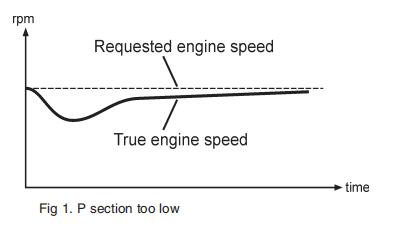
An increased value (Fig. 2) gives a shorter response time. Increase the P section for faster compensation to large differences in engine speed/engine loading.
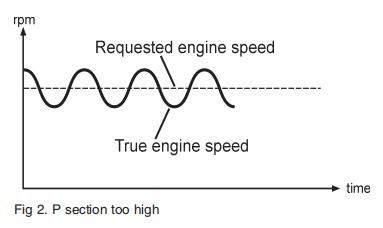
I-value stabilizes (Stability), reacts to the time of the speed deviation.
A reduced value (Fig. 3) increases the time taken by the system to respond after a load change. Reduce the I section to reduce the oscillations which are caused by slow application of engine loading.
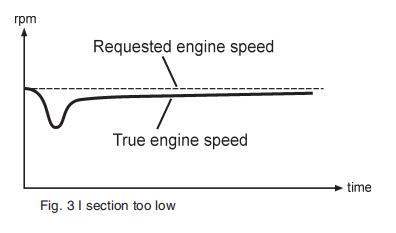
An increased value (Fig 4) gives a shorter response time. Increase the I-value to provide better load response for slowly increasing loads.
D-value compensates (Derivative). Reacts to fast changes of engine speed/load.
A reduced value (Fig 4.) gives a greater sensitivity to fast changes of engine speed/load. Reduce the D-value to reduce oscillations caused by fast changes.
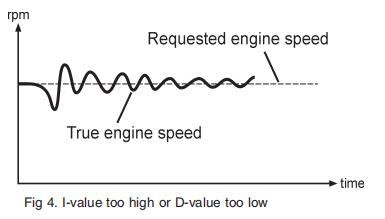
An increased value (Fig. 5) gives a reduced sensitivity to fast load changes. Increase the D-value to provide a better ability to compensate for fast changes.
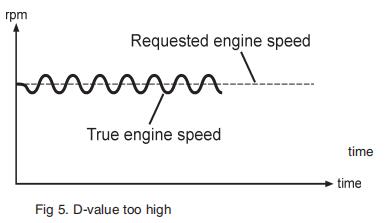
1. Start the engine.
2. Select the “Engine with mounting and equipment” and then “Reinforcement and Stability, calibration” function groups in the VODIA tool.
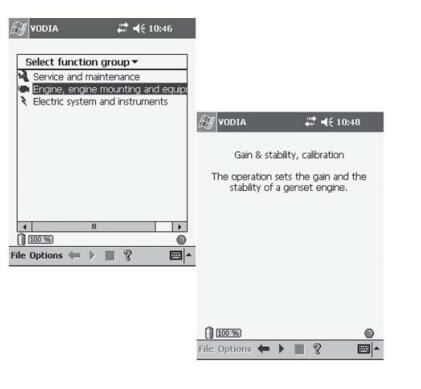
3. When calibration is started, certain conditions must be met, such as that the engine must be running and must have reached a certain engine temperature.
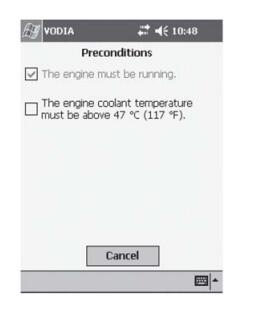
4. Select “High” or “Low”.
High: when one is far from the nominal engine speed, i.e. to improve load response.
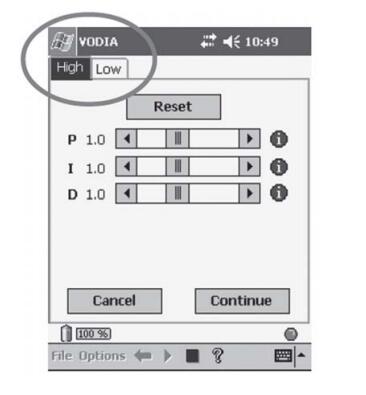
Low: when one is close to the nominal engine speed point, i.e. to increase stability.
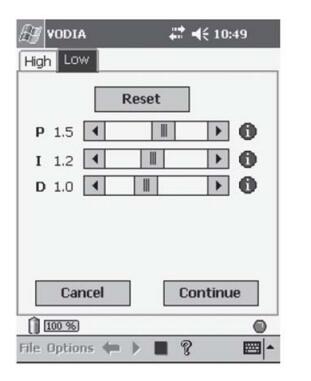
5. Run the engine at the working speed and working temperature.
In cases where the engine needs to be adjusted, in-crease or reduce the values of the P and I sections until unstable (oscillating) engine speed is obtained. Then increase/decrease the parameters until the engine speed is stable again.
6. If the engine is still unstable, increase/reduce the D section until engine speed only increases slightly when load is applied (or removed), please refer to figure 6.
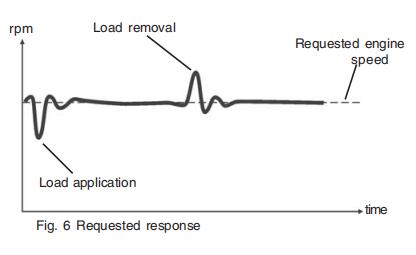
NOTE: The few times that the D-value may need to be adjusted include cases where the application has a flexible coupling or extremely low flywheel inertia.
7. Adjust the P and I sections again as above, if necessary.
8. Check engine response as fig. 6.
9. Repeat the procedure in the other position, “High”/“Low” if necessary.
10. To reset to factory settings, use the reset button above the PID settings.
11. Click “Continue” to finish calibration and follow the instructions to save the current settings in the control unit.
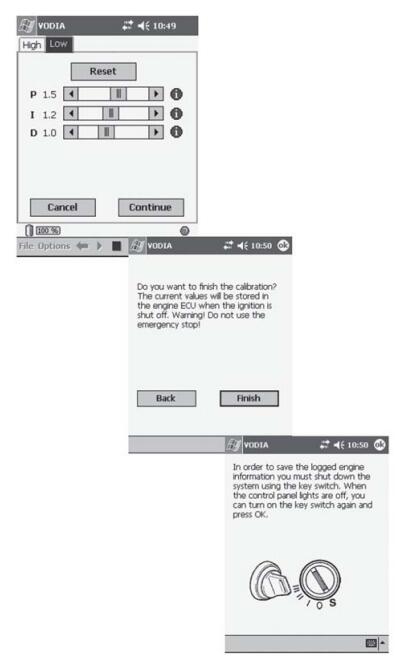
The routine for altering the engine speed on the TAD734GE is not the same as for, i.e. D12. There is no system reset on the EMS2 unit, and the routine is therefore completely different.
If the engine is a 1500 rpm or 1800 rpm, the frequency selector must be OPEN when you start the adjustment. OPEN selects the primary engine speed, CLOSED selects the secondary engine speed.
Routine, with no system voltage applied:
1. Turn on the ignition with the starter key or switch. 2. Change the frequency selector (open or closed). 3. Send a stop request by pressing on the stop button.
The whole procedure (steps 1 to 3) may not take longer than 10 seconds.
Routine, with system voltage applied:
1. Send a stop request by pressing on the stop button.
2. Change the frequency selector (open or closed).
3. Send a stop request by pressing on the stop but-ton.
The whole procedure (steps 1 to 3) may not take long-er than 10 seconds.
Turn on the ignition and change the parameter in the DCU.
Customers who use their own CAN bus-based control unit, must send certain messages to the engine (TAD734GE) in the same way as for the Volvo Pentas CIU, in order to change from 1500 to 1800 rpm (or vice-versa).
Routine, with no system voltage applied:
1. Turn on ECU.
2. Change the frequency selection in the
VP_STATUS-message (open or closed).
3. Send a stop request in a VP_STATUS-message.
The whole procedure (steps 1 to 3) may not take longer than 10 seconds.
Routine, with system voltage applied:
1. Send a stop request in a VP_STATUS-message.
2. Change the frequency selection in the
VP_STATUS-message (open or closed).
3. Send a stop request in a VP_STATUS-message.
The whole procedure (steps 1 to 3) may not take longer than 10 seconds.
NOTE: We are authorized as Volvo diesel generator OEM and can provide 85KVA to 750KVA power generator with Volvo engine. Volvo engine performance corresponds to ISO 3046, BS 5514 and DIN 6271. Engine speed governing in accordance with ISO 3046/IV, class A1 and ISO 8528-5 class G3. Besides, the engine complies with EU stage 2 emission legislation according to the Non Road Directive EU 97/68/EC.
Copyright © Guangxi Dingbo Generator Set Manufacturing Co., Ltd. All Rights Reserved | Sitemap
Update cookies preferences